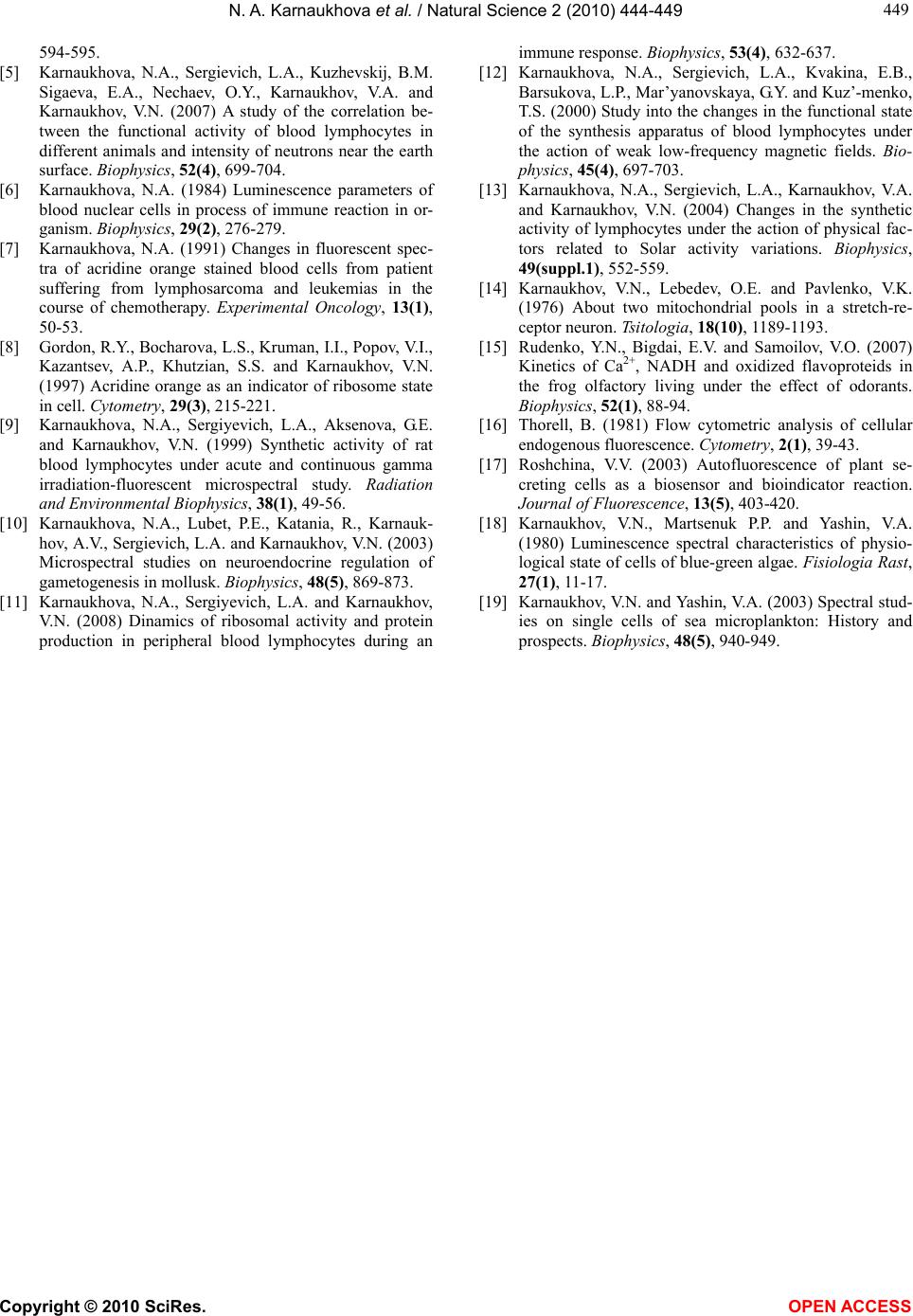
N. A. Karnaukhova et al. / Natural Science 2 (2010) 444-449
Copyright © 2010 SciRes. OPEN ACCESS
449
449
594-595.
[5] Karnaukhova, N.A., Sergievich, L.A., Kuzhevskij, B.M.
Sigaeva, E.A., Nechaev, O.Y., Karnaukhov, V.A. and
Karnaukhov, V.N. (2007) A study of the correlation be-
tween the functional activity of blood lymphocytes in
different animals and intensity of neutrons near the earth
surface. Biophysics, 52(4), 699-704.
[6] Karnaukhova, N.A. (1984) Luminescence parameters of
blood nuclear cells in process of immune reaction in or-
ganism. Biophysics, 29(2), 276-279.
[7] Karnaukhova, N.A. (1991) Changes in fluorescent spec-
tra of acridine orange stained blood cells from patient
suffering from lymphosarcoma and leukemias in the
course of chemotherapy. Experimental Oncology, 13(1),
50-53.
[8] Gordon, R.Y., Bocharova, L.S., Kruman, I.I., Popov, V.I.,
Kazantsev, A.P., Khutzian, S.S. and Karnaukhov, V.N.
(1997) Acridine orange as an indicator of ribosome state
in cell. Cytometry, 29(3), 215-221.
[9] Karnaukhova, N.A., Sergiyevich, L.A., Aksenova, G.E.
and Karnaukhov, V.N. (1999) Synthetic activity of rat
blood lymphocytes under acute and continuous gamma
irradiation-fluorescent microspectral study. Radiation
and Environmental Biophysics, 38(1), 49-56.
[10] Karnaukhova, N.A., Lubet, P.Е., Katania, R., Karnauk-
hov, А.V., Sergievich, L.A. and Karnaukhov, V.N. (2003)
Microspectral studies on neuroendocrine regulation of
gametogenesis in mollusk. Biophysics, 48(5), 869-873.
[11] Karnaukhova, N.A., Sergiyevich, L.A. and Karnaukhov,
V.N. (2008) Dinamics of ribosomal activity and protein
production in peripheral blood lymphocytes during an
immune response. Biophysics, 53(4), 632-637.
[12] Karnaukhova, N.A., Sergievich, L.A., Kvakina, E.B.,
Barsukova, L.P., Mar’yanovskaya, G.Y. and Kuz’-menko,
T.S. (2000) Study into the changes in the functional state
of the synthesis apparatus of blood lymphocytes under
the action of weak low-frequency magnetic fields. Bio-
physics, 45(4), 697-703.
[13] Karnaukhova, N.A., Sergievich, L.A., Karnaukhov, V.A.
and Karnaukhov, V.N. (2004) Changes in the synthetic
activity of lymphocytes under the action of physical fac-
tors related to Solar activity variations. Biophysics,
49(suppl.1), 552-559.
[14] Karnaukhov, V.N., Lebedev, O.E. and Pavlenko, V.K.
(1976) About two mitochondrial pools in a stretch-re-
ceptor neuron. Tsitologia, 18(10), 1189-1193.
[15] Rudenko, Y.N., Bigdai, E.V. and Samoilov, V.O. (2007)
Kinetics of Са2+, NADH and oxidized flavoproteids in
the frog olfactory living under the effect of odorants.
Biophysics, 52(1), 88-94.
[16] Thorell, B. (1981) Flow cytometric analysis of cellular
endogenous fluorescence. Cytometry, 2(1), 39-43.
[17] Roshchina, V.V. (2003) Autofluorescence of plant se-
creting cells as a biosensor and bioindicator reaction.
Journal of Fluorescence, 13(5), 403-420.
[18] Karnaukhov, V.N., Martsenuk P.P. and Yashin, V.A.
(1980) Luminescence spectral characteristics of physio-
logical state of cells of blue-green algae. Fisiologia Rast,
27(1), 11-17.
[19] Karnaukhov, V.N. and Yashin, V.A. (2003) Spectral stud-
ies on single cells of sea microplankton: History and
prospects. Biophysics, 48(5), 940-949.